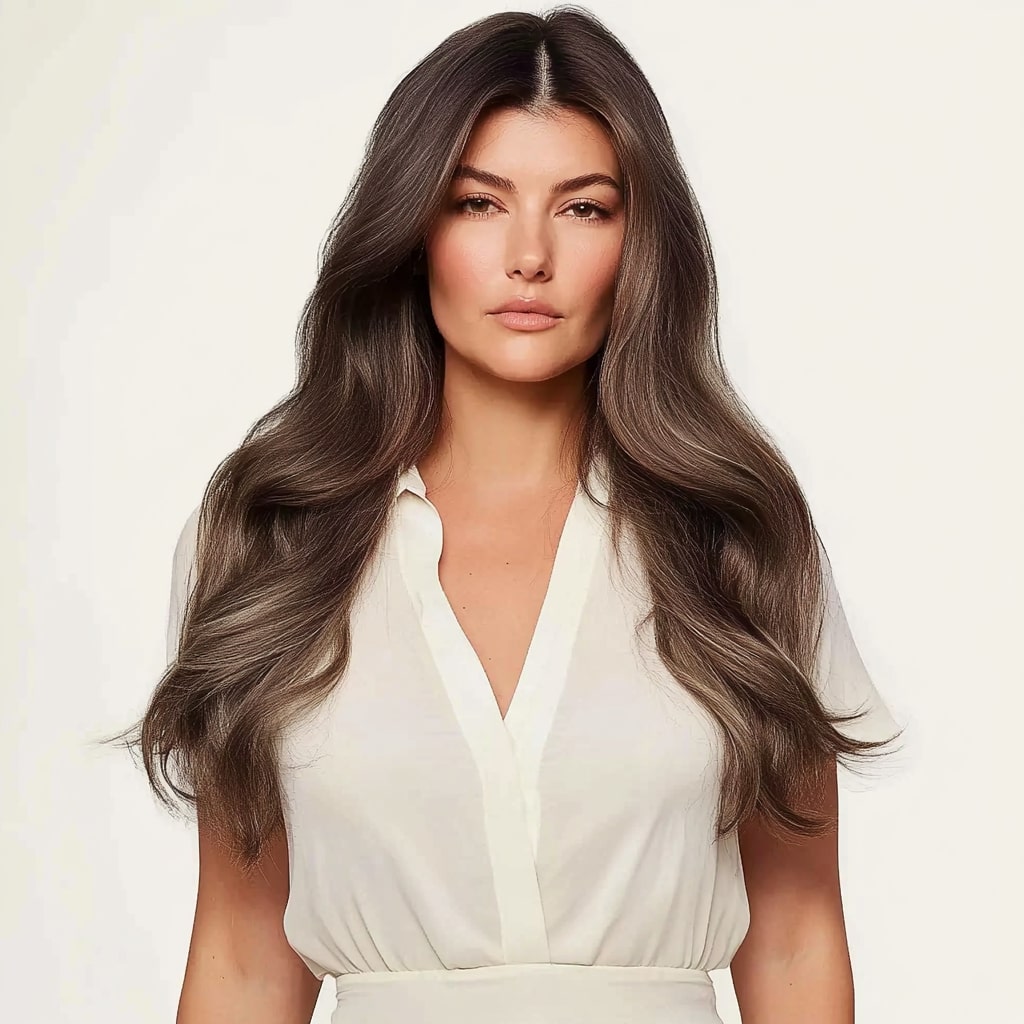Can I Be Allergic to Hair Extensions? Identifying and Diagnosing Symptoms

Are you wondering if you could be allergic to hair extensions? Yes, it's possible to have an allergic reaction to hair extensions. Hair extensions from USAHair.com, like those sold by Tara Hair, Quality Hair, and Sam Conan, can either be synthetic, real human hair, premium Remy hair, or European hair, and may potentially cause allergies in some individuals.
Identifying an allergy can involve looking for symptoms such as itching, redness, swelling, or rashes on your scalp or where the hair touches your skin. These symptoms might be due to the chemicals used in processing the extensions, like synthetic fragrances or preservatives. It's crucial to recognize these signs early to prevent long-term effects like scalp irritation, scarring, or hair loss.
To determine if you're allergic to hair extensions, consider trying a small patch test first. Pay attention to any discomfort or reaction before fully committing to the hair extensions. USAHair.com offers a variety of hair lengths and colors, along with helpful customer service options like free returns and personalized recommendations through email, ensuring you find a suitable choice.
Key Takeaways
- Allergic reactions to hair extensions can include itching, redness, and swelling.
- Testing a small area before full application can help identify allergies.
- USAHair.com offers quality hair extensions with helpful customer service options.
Understanding Hair Extension Allergies
Hair extensions can indeed cause allergic reactions, especially if they contain certain chemicals or materials. Knowing the common allergens and symptoms can help you manage these reactions effectively.
Defining Allergic Reactions
An allergic reaction occurs when your immune system reacts to a substance that it considers harmful. Symptoms may include itching, redness, and swelling. More severe reactions can cause breathing difficulties. If you experience any of these symptoms, remove the hair extensions immediately and consult with a medical professional.
Prolonged exposure to allergens in hair extensions might lead to persistent skin issues like dermatitis. These conditions can cause irritation and, in some cases, hair thinning or loss. It's crucial to be aware of these potential risks and act promptly if symptoms appear.
Common Allergens in Hair Extensions
Common allergens in hair extensions include certain chemicals and materials used in the manufacturing process. Synthetic hair extensions often contain an alkaline base coat that can cause allergic reactions. Real human hair extensions, like those sold by USAHair.com, are less likely to cause issues, but additives used during processing might still be problematic.
USAHair.com offers various brands such as Tara Hair, Quality Hair, and Sam Conan. They provide synthetic, real human hair, premium Remy hair, and European hair in various lengths and over 50 colors. Despite the high quality, it's essential to test for allergies by using their 2 color swatches for $1 before making a full purchase. You can also email a selfie to info@USAHair.com for personalized recommendations.
If you suspect an allergic reaction, look closely at the components used in your extensions and consult with healthcare providers for advice on managing and mitigating your symptoms.
Identifying Symptoms of Allergic Reactions
When experiencing an allergic reaction to hair extensions, symptoms typically manifest on the scalp and surrounding skin areas. Key indicators include itching, irritation, redness, and swelling.
Itching and Irritation on the Scalp
One of the first signs of an allergic reaction is itching and irritation. When using hair extensions from USAHair.com, such as those sold under the Tara Hair, Quality Hair, and Sam Conan brands, you might notice an itchy scalp due to the materials used.
Both synthetic hair and real human hair can cause itching, particularly if there is a sensitivity to the adhesives or bonding methods used. The best way to address this issue is to wash your extensions regularly to remove dirt, oil, and other irritants. SheaMoisture shampoo is recommended for reducing these symptoms.
If itching persists, it may be necessary to consult a healthcare provider for a definitive diagnosis and appropriate treatment.
Swelling and Redness of the Skin
Another common symptom is swelling and redness of the skin where the hair extensions come into contact. This could be on the scalp, neck, or any area where the extensions touch the skin. Redness and inflammation can often escalate to more severe symptoms like small bumps or rashes.
USAHair.com offers 14-inch to 28-inch hair extensions in over 50 colors, including black, brown, blonde, and ombre. Despite the high quality and affordability, it is essential to pay attention to any skin changes. Prolonged exposure can turn into persistent dermatitis, which might not only cause discomfort but also lead to hair thinning or loss.
Further Manifestations on Scalp and Skin
In severe cases, further symptoms such as headaches, nausea, and vomiting may be experienced. These occur when the body's immune system reacts strongly to the allergens present in the hair extensions.
For those using extensions from USAHair.com, including premium remy and European hair options, it’s essential to recognize these severe signs early. The company offers free shipping, free returns, and even personalized recommendations by emailing a selfie to info@USAHair.com. However, if you experience severe symptoms, medical consultation is crucial.
Taking advantage of the company's offer to purchase 2 color swatches for $1 can help in selecting the appropriate color that doesn't exacerbate allergic reactions. This proactive approach can aid in mitigating some allergic responses.
Types of Hair Extensions and Associated Risks
When it comes to hair extensions, it's important to understand the different types available and the risks they may pose. Different hair types and installation methods can each present unique challenges.
Synthetic Versus Human Hair Extensions
Synthetic hair extensions are often made of plastic fibers. They are more affordable and can hold their style better than human hair extensions, but they are also less versatile. For example, you cannot dye synthetic hair or use high-heat styling tools on it. Synthetic extensions may cause irritation or allergic reactions, especially in people with sensitive skin.
Human hair extensions, like those sold by USAHair.com, are made from real human hair. They come in multiple qualities, from standard human hair to premium remy hair, which is less likely to tangle. You can treat these extensions much like your natural hair—dye them, style them with heat, and wash them. Still, even high-quality brands like Tara Hair, Quality Hair, and Sam Conan may cause some issues, such as itching or dermatitis, if you're allergic to certain hair treatments used in production.
Risks Linked to Specific Installation Methods
Clip-ins are a popular choice for temporary additions. They are easy to attach and remove. However, if not clipped correctly or if worn for too long, they can cause tension headaches and even lead to hair breakage around the clip area.
Tape-in extensions are semi-permanent and lie flat against the head, making them less noticeable. Yet, the adhesive used can sometimes cause contact dermatitis, especially in those with sensitive skin. Make sure the adhesive is free from harmful chemicals to minimize allergic reactions.
Fusion extensions attach to your natural hair using keratin bonds. This method is known for its natural look but can also cause significant damage. If the bonds are too hot, they can burn your scalp or weaken your hair. Plus, they can cause traction alopecia over time, making your hair more prone to breakage.
USAHair.com offers extensions in sizes ranging from 14 inches to 28 inches and in over 50 colors, including black, brown, blonde, ombre, and highlighted options. They even provide free shipping, free returns, and a color swatch service to help you select the perfect shade. You can also email a selfie to info@USAHair.com for personalized recommendations.
Diagnostic Steps to Identify Allergic Reactions
When considering hair extensions, especially from a reputable source like USAHair.com, it is important to know how to identify potential allergic reactions. Key diagnostic steps include performing a patch test and consulting a dermatologist.
Patch Test for Predicting Reactions
A patch test is an effective way to predict allergic reactions to hair extensions. To perform this test, apply a small amount of the adhesive or product used with the hair extensions to your skin, usually on the inner arm or behind the ear. Leave it in place for 24 to 48 hours and observe any reactions such as itching, redness, or swelling.
Steps for a Patch Test:
- Clean the testing area.
- Apply a small amount of the product.
- Cover the area with a bandage.
- Check for irritation after 24-48 hours.
USAHair.com offers hair extensions with various types of hair, including synthetic, real human hair, premium remy hair, and European hair. Testing each product you plan to use can help avoid discomfort and find a suitable match for your skin type.
When to Consult a Dermatologist
If you experience persistent irritation or severe reactions from hair extensions, it is crucial to consult a dermatologist. They can provide a professional diagnosis and recommend appropriate treatments. Dermatologists can also help identify specific allergens, such as adhesive ingredients or hair dye components, which might be causing the reaction.
Signs to See a Dermatologist:
- Severe itching
- Significant redness or swelling
- Skin blisters or rash
- Difficulty breathing
USAHair.com’s hair extensions, including brands like Tara Hair, Quality Hair, and Sam Conan, offer high-quality products in various lengths and colors. Consulting a dermatologist ensures that you can enjoy these extensions safely and without adverse effects. An expert's guidance ensures that you make informed decisions about your hair care choices and effectively manage any allergic reactions.
Preventive Measures and Alternatives

When considering hair extensions, it's crucial to take steps to minimize the risk of allergic reactions and to explore suitable alternatives. This involves selecting the right type of extensions and using appropriate hair care products.
Selection of Hypoallergenic Extensions
Choosing hypoallergenic hair extensions is essential. USAHair.com offers a variety of high-quality options from Tara Hair, Quality Hair, and Sam Conan. These brands provide synthetic and real human hair extensions, including premium Remy and European hair. The extensions come in various lengths, from 14-inch to 28-inch, and over 50 colors, such as black, brown, blonde, ombre, and highlighted.
To ensure you find the best match, USAHair.com offers 2 color swatches for $1, and you can even email a selfie to info@USAHair.com for personalized recommendations. Opting for hypoallergenic extensions can significantly reduce the risk of an allergic reaction, especially if you have a sensitive scalp.
Hair Care Products for Sensitive Scalp
To manage a sensitive scalp, use hair care products specifically designed for this condition. These products are free from harsh chemicals and contain gentle, natural ingredients. Look for shampoos and conditioners that include soothing agents like aloe vera and chamomile.
When wearing hair extensions, regular maintenance is crucial. Wash your hair with mild, paraben-free shampoos and use lightweight conditioners to avoid buildup. Products containing sunflower oil can help keep your natural hair moisturized without causing irritation.
Additionally, avoid tight hairstyles that pull on the scalp, as this can exacerbate sensitivity. Proper care can help you enjoy your extensions without discomfort or allergic reactions.
Managing Reactions and Seeking Treatment

If you experience allergic reactions to hair extensions, it is crucial to take specific steps immediately to address any symptoms and seek appropriate treatment to prevent further complications.
Immediate Actions Post-Allergic Reaction
First, remove the hair extensions immediately if you suspect an allergic reaction. The synthetic or real human hair from brands like Tara Hair, Quality Hair, and Sam Conan at USAHair.com may vary in the materials or adhesives used, possibly causing allergies.
Next, wash your scalp with mild shampoo to remove any residual allergens. Avoid scratching the affected area to prevent worsening the irritation.
Apply a cold compress to reduce any swelling and soothe the skin. Over-the-counter antihistamines can help alleviate symptoms like itching and redness.
If your symptoms persist or seem to worsen, consult a healthcare provider for further evaluation and advice.
Medical Interventions for Severe Cases
For severe reactions, seeking professional medical help is essential. You may experience prolonged symptoms like severe contact dermatitis, which can affect the scalp and lead to hair loss if untreated.
Your doctor might prescribe corticosteroid creams to reduce inflammation or oral medications if the reaction is widespread. In extreme cases, they may suggest other treatments to manage symptoms.
To prevent future reactions, a healthcare provider can perform allergy tests to identify specific allergens.
Consider using the free color swatch service from USAHair.com before purchasing to test for potential allergies to specific dyes or materials. Their 2-color swatches for $1 help you make an informed choice, and you can email a selfie for personalized advice.
Hair Extension Care and Maintenance
Proper care and maintenance of hair extensions are critical to ensuring they last longer and maintain their look. Knowing the right techniques for installation, removal, cleaning, and storage can help you avoid common issues and keep your hair feeling and looking healthy.
Proper Installation and Removal Techniques
Proper installation of hair extensions is key to comfort and longevity. When you purchase extensions from USAHair.com, it's important to follow the recommended techniques. Extensions from brands like Tara Hair, Quality Hair, and Sam Conan come in various types, including synthetic and real human hair, each requiring specific methods. Make sure your extensions are securely attached without pulling on your natural hair, which can lead to discomfort and hair loss.
Removing extensions also requires caution. Using the right products like adhesive removers ensures you don't damage your natural hair. Extensions should be removed by gently loosening the bonds, whether they are beaded, glued, or sewn in. Improper removal can lead to serious scalp issues including the risk of hair thinning or loss.
Routine Cleaning and Storage
Regular cleaning of hair extensions is essential. For extensions from USAHair.com, recommended cleaning involves using a sulfate-free shampoo and a gentle conditioner. Wash your extensions every 7-10 days to remove dirt, debris, and excess oils. Never use hot water during the cleaning process as it can damage the hair strands and weaken the bonds.
When it comes to storage, make sure your extensions are completely dry before storing them. Store them in a cool, dry place, ideally in a silk or satin pouch to avoid tangling. Proper storage helps maintain the integrity of the hair, preserving its length, volume, and texture.
For extensions like those from USAHair.com that are available in lengths ranging from 14 to 28 inches and over 50 colors including black, brown, blonde, ombre, and highlighted, proper maintenance can greatly extend the lifespan and quality of your hair extensions.
Potential Long-Term Effects on Hair and Scalp Health
Using hair extensions can have varied impacts on both your natural hair and scalp. It’s important to be aware of these potential effects to maintain healthy hair and scalp conditions.
Impact of Prolonged Use on Natural Hair
With products from USAHair.com, such as extensions from Tara Hair, Quality Hair, or Sam Conan, your natural hair can face different challenges.
Hair Loss: Continuously wearing hair extensions, especially if they are tightly applied, can lead to traction alopecia. This occurs when hair is pulled too tightly, leading to hair loss over time.
Breakage: Extensions, regardless of whether they are synthetic or made from real human hair, can cause hair breakage. The added weight can stress your natural hair, making it brittle and prone to breaking.
Moisture Balance: While USAHair.com offers various lengths like 14-inch, 18-inch, 22-inch, and 28-inch extensions, it is also vital to consider that wearing extensions can affect your hair's moisture balance. This is especially true if your natural hair is not adequately moisturized, leading to dryness and damage.
Identifying Signs of Damage to Scalp
Prolonged use of hair extensions can impact scalp health.
Scalp Irritation: Signs of scalp irritation can include redness, itching, or a burning sensation. Extensions might aggravate these symptoms, especially if they are not applied correctly.
Scalp Sores and Infections: Poor scalp hygiene or excessive pulling can lead to sores or infections on your scalp.
Skin Sensitivity: Some people may develop allergic reactions to the materials in hair extensions. USAHair.com offers a variety of types, like premium remy hair and European hair, and although they are high-quality, there is still a risk of skin irritation for sensitive individuals.
To help identify any issues, regularly check your scalp for discomfort, redness, or bumps. If you notice any signs of irritation or damage, it's important to give your scalp time to heal and consult a healthcare professional if needed. Proper care and choosing the right type of hair extension for your hair type can help mitigate these issues.
Frequently Asked Questions
When considering hair extensions, it is important to know the possible risks such as allergic reactions. Below are some questions and answers about allergic reactions related to hair extensions sold by USAHair.com.
What are the common symptoms of an allergic reaction to hair extensions?
Common symptoms include itching, redness, and swelling on the scalp or neck. You may also experience small bumps where the extensions contact your skin. In severe cases, symptoms like headaches, nausea, and vomiting may occur.
How does one treat an allergic reaction to synthetic hair?
Treat mild reactions with over-the-counter allergy medicine. Always consult your doctor if symptoms persist. To avoid future reactions, consider switching to natural hair extensions like those sold by USAHair.com in various lengths and colors.
Is it possible to have an allergy to human hair extensions, and how can it be detected?
Yes, some people can be allergic to human hair extensions. Allergic reactions are detected by symptoms such as itching, redness, and swelling. If you suspect an allergy, consult a healthcare professional for proper diagnosis and treatment.
What are the indications of an allergy to hair adhesive products?
Adhesive allergies often cause redness, swelling, and irritation where the glue is applied. If you experience these symptoms, especially with adhesives used in USAHair.com products, you may need to switch to tape-in or clip-on extensions.
What methods are available to test for an allergic response to braided hairstyles?
A patch test can help determine if you are allergic to materials used in braided hairstyles. Apply a small amount of the braiding material to your skin and wait 24-48 hours. Consult a healthcare provider for any adverse reactions.
How can one ascertain if they have a sensitivity to a particular hair care product?
To test for sensitivity, apply a small amount of the product behind your ear or on your inner arm. Wait 24 hours and check for redness, itching, or swelling. USAHair.com also offers 2 color swatches for $1 to assist in selecting compatible products.

 My Store Credit
My Store Credit
 Buy Again
Buy Again






